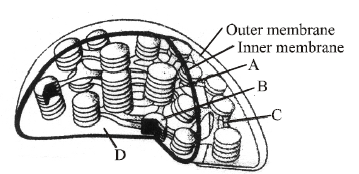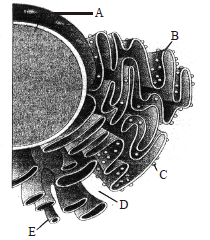Please refer to Cell The Unit of Life Class 11 Biology Important Questions with solutions provided below. These questions and answers have been provided for Class 11 Biology based on the latest syllabus and examination guidelines issued by CBSE, NCERT, and KVS. Students should learn these problem solutions as it will help them to gain more marks in examinations. We have provided Important Questions for Class 11 Biology for all chapters in your book. These Board exam questions have been designed by expert teachers of Standard 11.
Class 11 Biology Important Questions Cell The Unit of Life
Objective Questions
Question. Which statement about ER is not true?
(a) It is of two types, rough, smooth
(b) It is a network of tubes and flattened sacs
(c) Some of it is sprinkled with ribosome
(d) It is found in all living cells
Answer
D
Question. A. It contains water, sap excretory product and other unwanted materials
B. It is bound by a single membrane called tonoplast
C. In plant cells it can occupy upto 90% of cellular volume
D. Its content forms cell sap
E. It maintains turgor pressure
The above features are attributed to
(a) Lysosome
(b) Vacuole
(c) Peroxisome
(d) Food vacuole
Answer
B
Question. The concentration of a number of ions and other materials is higher in vacuoles than those in cytoplasm why
(a) Tonoplast has a number of active transport system that pumps ions into vacuole for cytoplasm
(b) Through osmosis a large amount of ions go continuously to vacuole from cytoplasm
(c) Cytoplasmic ions enters the vacuole through osmotic flow of water
(d) The vacuole is always engaged in the hydrolysis of salts into their ions
Answer
A
Question. RNA is found in all of the following structures except
(a) Prokaryotic cell
(b) Nucleus, chloroplast and mitochondria
(c) Vacuole
(d) Ribosome, HIV, TMV
Answer
C
Question. Which of the following statement is incorrect?
(a) Mitochondria, unless specifically stained are not easily visible under the microscope
(b) Physiological activity of cells determines the number of mitochondria per cell
(c) Mitochindria, a power house of cell has DNA, RNA ribsosomes and enzyme so it can survive outside the cell
(d) Mitochondria divides by fusion
Answer
D
Question. Choose the correct statement
A. Mitochondria and chloroplast transfer energy
B. Mitochondrion is a power house of cell as it produces most of the cellular ATP
C. Mitochondria and chloroplast are found in all eukaryotic cell
D. Mitochondria are sites of anaerobic respiration
E. The matrix of mitochondria posses a single linear DNA, many RNA molecules 80s ribosomes
Options :
(a) D,E
(b) A,B
(c) B,D,E
(d) C,E
Answer
B
Question. A. Sausage shaped/cylindricaL
B. Diameter 0.2- 1.0 um length 1.0-4.1um
C. Has 2 aqueous compartments
D. Outer membrane as continuous limiting boundary of organelle
E. Inner membrane forms many cristae which increase surface area
All the above statements are attributed to
(a) Chloroplast
(b) Nucleus
(c) ER
(d) Mitochondria
Answer
D
Question. Which group of structures would be clearly seen in a suitable stained plant cell under light microscope?
(a) Chloroplast, mitochondria, nucleus and ribosomes
(b) Chloroplast, mitochondria, vacuole, nucleus, starch grain
(c) ER, GB, ribosome
(d) GB, ER, ribosome, mitochondria
Answer
B
Question. Which of the following cell organelles were discovered after the introduction of electron microscope?
(a) Mitochondria
(b) Endoplasmic reticulum
(c) Ribosomes
(d) Both (b) and (c)
Answer
D
Question. Golgi apparatus is concerned with
(a) excretion
(b) secretion
(c) ATP synthesis
(d) RNA synthesis
Answer
A
Question. Function of contractile vacuole in Amoeba is
(a) excretion and osmoregulation.
(b) digestion and respiration.
(c) osmoregulation and transportation.
(d) none of the above.
Answer
A
Question. Plastids are found in
(a) all animal cells.
(b) some animal cells.
(c) all plant cells.
(d) all plant cells and euglenoides.
Answer
D
Question. Grana are
(a) protein storing plastids.
(b) coloured plastids.
(c) stacks of thylakoids.
(d) individual thylakoids present in stroma.
Answer
C
Question. The cytoskeleton is a proteinaceous network of fibres in the cytoplasm. It is involved in
(a) mechanical support.
(b) motility.
(c) maintenace of cell-shape.
(d) all of these
Answer
D
Question. Prokaryotic and eukaryotic flagella differ in the
(a) type of movement and placement.
(b) location and mode of functioning.
(c) microtubular structure and function.
(d) microtubular organization and type of movement.
Answer
D
Question. Centrioles and centrosomes occur in the cells of
(a) green plants
(b) animals
(c) bacteria and cyanobacteria
(d) both (b) and (c)
Answer
B
Question. Satellite means
(a) terminal part of the chromosome beyond secondary constriction.
(b) terminal part of the chromosome beyond primary constriction.
(c) terminal part of chromosome beyond tertiary constriction.
(d) none of the above
Answer
A
Statement Type Questions
Question. Which of the following is incorrect ?
(a) Mycoplasma is the smallest cell (0.3 μ).
(b) Bacteria are 3 to 5 μm in size.
(c) The largest cell is the egg of an ostrich.
(d) Nerve cells are some of the smallest cells.
Answer
D
Question. Select the statements which are related to Schwann.
(i) He reported that cells have a thin outer layer which is today known as plasma membrane
(ii) Cell wall is a unique character of the plant cell.
(iii) Body of plants and animals are composed of cells and products of cells.
(a) Only (i)
(b) Only (iii)
(c) (i) and (iii)
(d) All of these
Answer
D
Question. Study the following statements on cilium or flagellum and answer the question.
(i) Cilium / Flagellum contains an outer ring of nine doublet microtubules surrounding two singlet
microtubules.
(ii) Cilia are smaller which work like oars, causing the movement of either the cells or surrounding fluid.
(iii) Flagella are comparatively longer and responsible for cell movement.
(iv) Cilium and flagellum are covered with plasma membrane.
Which of the above statements are correct?
(a) (i) and (ii)
(b) (i), (ii), (iii) and (iv)
(c) (i) and (iv)
(d) (ii) and (iii)
Answer
B
Question. Read the folowing statements and identify the correct option.
(i) Contractile vacuole takes part in osmoregulation and excretion.
(ii) Food vacuole is formed by engulfing the food particles.
(iii) The vacuole is bound by a double membrane called tonoplast.
(iv) Vacuole can occupy upto 90 percent of the volume of the cell.
(a) (i) and (ii)
(b) (ii) and (iv)
(c) (i), (ii) and (iv)
(d) None of the above
Answer
C
Question. Which of the following statements is/are correct ?
(i) The endomembrane system includes plasma membrane, ER, Golgi complex, lysosomes and
vacuoles.
(ii) ER helps in the transport of substances, synthesis of proteins, lipoproteins and glycogen.
(iii) Ribosomes are involved in protein synthesis.
(iv) Mitochondria help in oxidative phosphorylation and generation of ATP.
(a) (ii), (iii) & (iv)
(b) (i) only
(c) (ii) only
(d) (iii) only
Answer
A
Question. Which of the following statements are correct ?
(i) In prokaryotic cells, a special membranous structure formed by the extension of the plasma
membrane into the cell is known as polysome.
(ii) The smooth endoplasmic reticulum is the major site for synthesis of glycoproteins.
(iii) RuBisCO is the most abundant protein in the whole biosphere.
(iv) Mitochondria, chloroplasts and peroxisomes are not considered as part of endomembrane system.
Of the above statements
(a) (iii) and (iv)
(b) (i) and (ii)
(c) (ii) and (iii)
(d) (i) and (iv)
Answer
A
Question. Given below are some characters of a cell organelle.
Identify the correct organelle which shows all the characters described above.
(i) It is a membrane bound space found in the cytoplasm.
(ii) It is bound by a single membrane called tonoplast.
(iii) It contains water, sap, excretory products and other materials not useful to the cell.
(iv) It has higher concentration of sap than the cytoplasm.
(a) Golgi apparatus
(b) Lysosomes
(c) Endoplasmic reticulum
(d) Vacuoles
Answer
D
Question. Which of the following statements are correct?
(a) Na+/K+ pump is an example of active transport.
(b) In plant cells lipid like steroidal hormones are synthesized in SER.
(c) In plant cells, the vacuoles can occupy up to 10% of the volume of the cell.
(d) Chlorophyll and leucoplast are responsible for trapping light energy essential for photosynthesis.
Answer
A
Assertion/Reason Type Questions
In the following questions, a statement of Assertion is followed by a statement of Reason.
(a) If both Assertion and Reason are true and the Reason is the correct explanation of the Assertion.
(b) If both Assertion and Reason are true but the Reason is not the correct explanation of the Assertion.
(c) If Assertion is true but Reason is false.
(d) If both Assertion and Reason are false.
Question. Assertion : Centrosomes and centrioles are related to each other.
Reason : Centrosome usually contains two cylindrical structures called centrioles.
Answer
A
Question. Assertion : The quasifluid nature of lipid enables lateral movement of proteins within the overall bilayer.
Reason : This ability to move within the membrane is called fluidity and is important for cell growth.
Answer
B
Question. Assertion : A plant cell bursts if placed in water.
Reason : High turgor pressure causes bursting of plant cells.
Answer
D
Matching Type Questions
Question. Match column-I and column-II and select the correct answer
| Column-I | Column-II |
| A. Bacteria without walls | I. Lysosome |
| B. Small circular DNA | II. Mycoplasma cells |
| C. Flattened sacs in | III. Thylakoid a chloroplast |
| D. A vesicle in which | IV. Plasmid hydrolytic enzymes are stored |
(a) A – III; B – IV; C – II; D – I
(b) A – II; B – IV; C – III; D – I
(c) A – I; B – II; C – III; D – IV
(d) A – IV; B – III; C – I ; D – II
Answer
B
Question. Choose the incorrect match.
(a) Nucleus — RNA
(b) Lysosome — Protein synthesis
(c) Mitochondria — Respiration
(d) Cytoskeleton — Microtubules
Answer
B
Question. Which of these is wrongly matched?
(a) Chloroplasts – Chlorophyll
(b) Elaioplasts – Starch
(c) Chromoplasts – Carotenoids
(d) Amyloplasts – Carbohydrates
Answer
B
Question. Which of the following pair are correctly matched ?
(I) Amyloplasts – Store proteins
(II) Mitochondrion – ‘Power house’ of the cell
(III) Stroma – Chlorophyll pigment
(IV) Axoneme – 9 + 2 array
(a) (I) and (III) only
(b) (II), (III) and (IV) only
(c) (III) and (IV) only
(d) (II) and (IV) only
Answer
D
Question. Match Column I with Column II and choose the correct option.
| Column I | Column II |
| A. Centrioles | I. Non-membrane bound organelle which helps in cell division |
| B. Fimbriae | II. Special structure of bacteria which help them to attach with rocks in stream and also to host tissue |
| C.Endomembrane | III. Includes those organelles system whose functions are coordinated |
| D. Mitochondria | IV. Divide by fission and site of aerobic respiration |
(a) A – I; B – II; C – III; D – IV
(b) A – III; B – I; C – II; D – IV
(c) A – III; B – I; C – IV; D – II
(d) A – I; B – IV; C – III ; D – II
Answer
A
Critical Thinking Type Questions
Question. In which method of transport, plasma membrane does not require carrier molecule?
(a) Active transport
(b) Facilitated diffusion
(c) Simple diffusion
(d) Na+ – K+ pump
Answer
C
Question. Which of the following pair lack the unit membrane?
(a) Nucleus and E.R.
(b) Mitochondria and chloroplast
(c) Ribosome and nucleolus
(d) Golgi body and lysosome
Answer
C
Question. Active transport differs from passive transport in that active transport
(a) requires energy.
(b) always requires input of ATP.
(c) moves molecules against a concentration gradient.
(d) both (a) and (c)
Answer
D
Question. You are asked to examine a cell using a powerful light microscope. The image you see has a clearly defined nucleus and mitochondria. It also has a large central vacuole and chloroplasts. From what group of organisms did this cell most likely come?
(a) Bacteria
(b) Protists
(c) Fungi
(d) Plants
Answer
D
Question. Which of the following organelles is directly connected to the outer membrane of the nucleus in a eukaryotic cell?
(a) Mitochondrion
(b) Lysosome
(c) Golgi apparatus
(d) Endoplasmic reticulum
Answer
D
Diagram Type Questions
Question. Identify the components labelled A, B, C and D in the given section of cilia/flagella showing different parts.
Choose the option which shows the correct labelling of parts.

(a) A – Plasma membrane, B – Interdoublet bridge, C – Central microtubule, D – Radial spoke
(b) A – Plasma membrane, B – Arm, C – Central microtubule, D – Radial spoke
(c) A – Plasma membrane, B – Interdoublet bridge, C – Hub, D – Radial spoke
(d) A – Plasma membrane, B – Interdoublet bridge, C– Hub, D – Arm
Answer
A
Question. Which of the following option correctly match A, B, C, and D indicated in the given sectional view of chloroplasts.

(a) A – Thylakoid, B-Stromal lamella, C – Stroma, D – Granum
(b) A – Granum, B – Thylakoid, C – Stromal lamella, D – Stroma
(c) A – Thylakoid, B – Granum, C – Stromal lamella, D – Stroma
(d) A – Granum, B – Thylakoid, C – Stroma, D – Stromal lamella
Answer
B
Question. Identify the components labelled as A, B, C, D and E in the diagram given below from the list (i) to (viii).

(i) Cristae of mitochondria
(ii) Inner membrane of mitochondria
(iii) Cytoplasm
(iv) Smooth endoplasmic reticulum
(v) Rough endoplasmic reticulum
(vi) Mitochondrial matrix
(vii) Ribosome
(viii) Nucleus

Answer
A
Question. The given figures show two types of cell. Which structures are common to both the cells?

(a) Nucleus and cell wall
(b) Nucleus and cytoplasm
(c) Ribosomes and flagella
(d) Ribosomes and cell wall
Answer
D
(Directions): Refer the given figure of animal cell with few structure marked as W, X, Y and Z. On the basis of this figure answer the following questions.

Question. Which function is carried out by the cell organelle ‘X’?
(a) helps control the movement of substance in and out of the cell
(b) passes information from the parent cell to newly formed cell
(c) maintains the proper shape of the cell and serves as a protective barrier
(d) helps the cell to make food with the help of chlorophyll and sunlight
Answer
A



